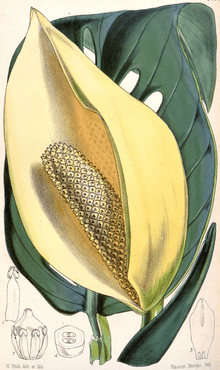Monstera adansonii
From Wikipedia, the free encyclopedia
| Monstera adansonii | |
|---|---|
 | |
| Scientific classification | |
| Kingdom: | Plantae |
| (unranked): | Angiosperms |
| (unranked): | Monocots |
| Order: | Alismatales |
| Family: | Araceae |
| Subfamily: | Monsteroideae |
| Tribe: | Monstereae |
| Genus: | Monstera |
| Species: | M. adansonii |
| Binomial name | |
| Monstera adansonii Schott. | |
| Synonyms[1] | |
| |
Monstera adansonii, five holes plant is a species of flowering plant from Araceae family which can be found in Brazil, Ecuador and Peru.[2] Besides South American land countries it can also be found on islands such as Antigua, Grenada, Saba, St. Kitts, Guadeloupe, Marie Galante, Dominica, Martinique, St. Lucia, St. Vincent, Tobago, and Trinidad. The species are quite common near river valleys at lower elevations.[3]
Description
Culms are 1 centimetre (0.39 in) long while leaves are 21–42 centimetres (8.3–16.5 in) long and 0.5–1 centimetre (0.20–0.39 in) wide. The fruits are 1.5–1.8 centimetres (0.59–0.71 in) long and 0.7 centimetres (0.28 in) wide.[1]
References
- ↑ 1.0 1.1 "Monstera adansonii - Costela-de-adão". Flora SBS. Retrieved June 4, 2013.
- ↑ "Monstera adansonii Schott.". University of Connecticut. Retrieved June 4, 2013.
- ↑ "Monstera adansonii Schott, Wiener Z. Kunst" 4. pp. 1028–1830.
This article is issued from Wikipedia. The text is available under the Creative Commons Attribution/Share Alike; additional terms may apply for the media files.